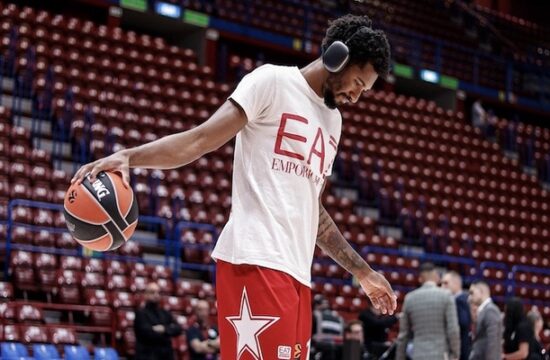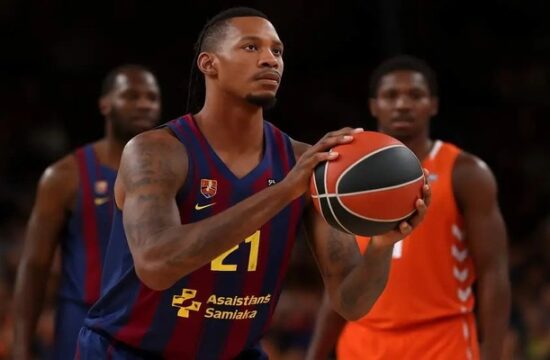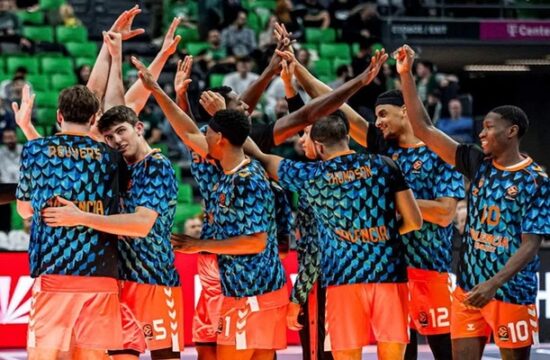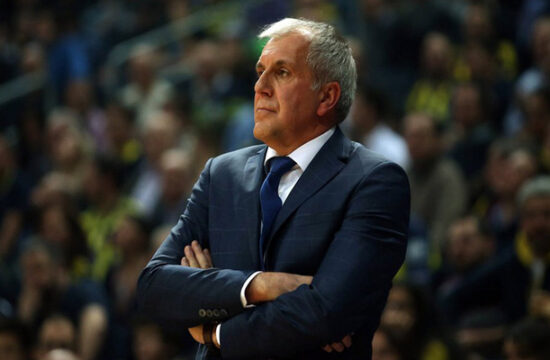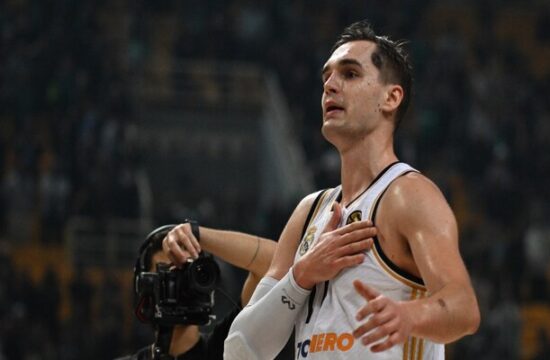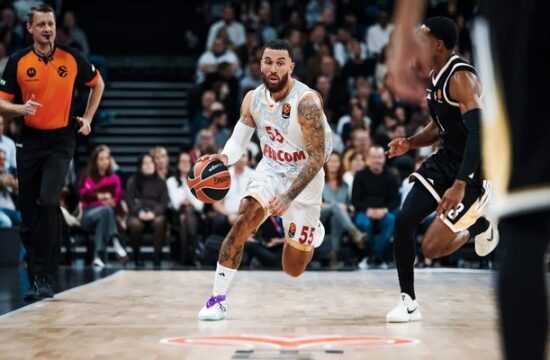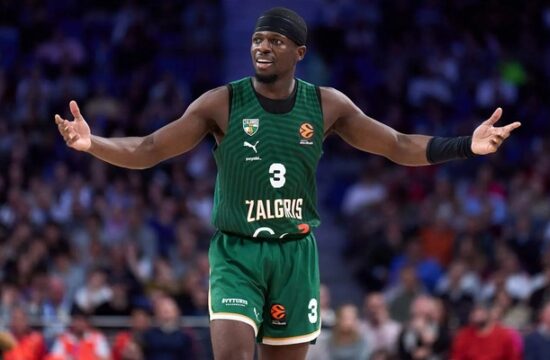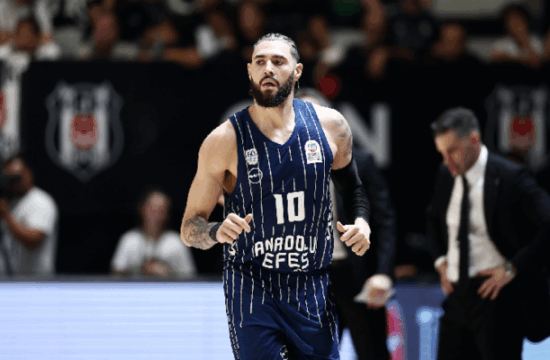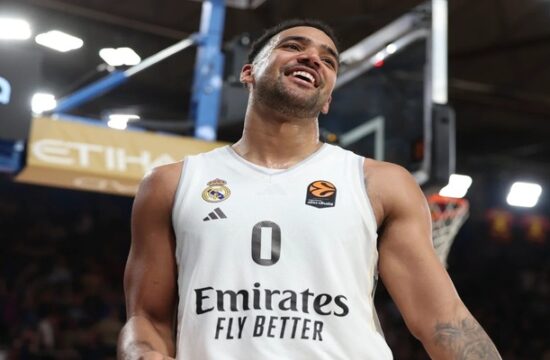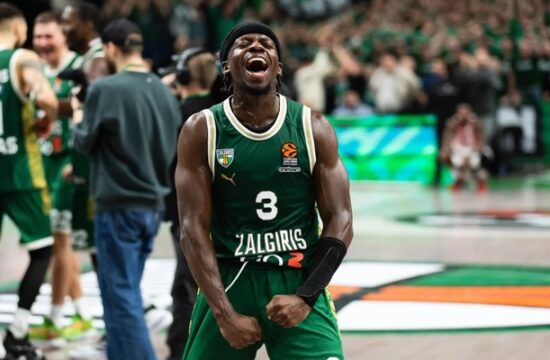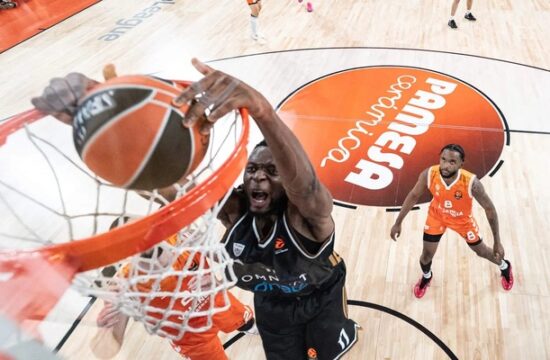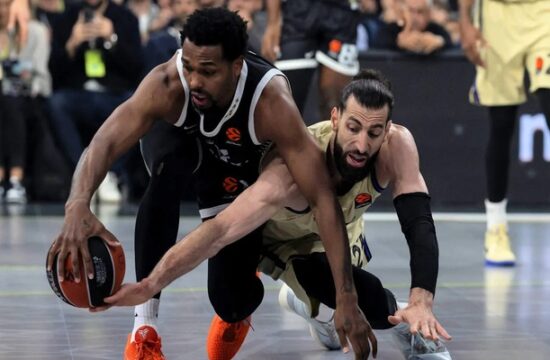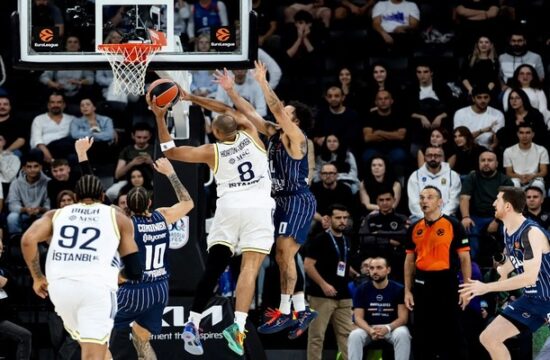The Games of week 11:
EA7 Milano vs Panathinaikos
Milano, one of the world’s fashion capitals, felt like the perfect runway for EA7 Milano versus Panathinaikos. Big personalities, elite talent, a few surprises, and plenty of moments where the crowd leaned forward in its seat.
The game opened at a sprint. Both teams leaned heavily into pick and roll, but with very different accents. Milano layered their offense with off ball movement before and during the main action, while Panathinaikos simplified things by putting the ball in their guards’ hands and spacing the floor for middle ball screens. Both approaches worked. The defenses had little margin for error, and at the first media timeout it was a one point game, 15 to 14 Milano. Shavon Shields was the early tone setter with eight quick points, but Ataman’s group flipped the switch out of the stoppage. A sharp 7 to 0 run in under two minutes forced Coach Poeta to burn a timeout, with Kenneth Faried doing damage as a roller. After that, scoring became harder to find. Milano’s pick and roll coverage, switching one through four and weakening the ball handler when the screener was the five, finally slowed Panathinaikos down. Not enough to win the quarter, though. Panathinaikos closed the first up 26 to 21.
The second quarter belonged to Milano. Their offense hummed with spacing, movement, layered actions and crisp ball movement. A 15 to 5 burst in just over three minutes swung the lead back to 36 to 31 and forced Ataman into a timeout. The momentum stuck. Milano’s guards dictated the tempo, no small feat against a Panathinaikos guard group like this one. Ellis and Guduric were calm and precise. For the visitors, offensive rebounding was the lifeline, keeping them afloat and fueling a late 7 to 2 run that trimmed the halftime deficit to 54 to 44. Still, the quarter can be summed up with one name. Armoni Brooks. He had 20 points at the break, 17 of them in the second quarter alone, drilling five of six from deep and sending the Unipol Forum into full voice after every make.
The third quarter opened with Shavon Shields grabbing the spotlight again. Five quick points powered a 10 to 2 run, stretching Milano’s lead to 18 with 6:30 left, helped by Panathinaikos turnovers. The response came quickly. Sloukas and Nunn steadied things, cutting the margin to 14 at the next media timeout. But Milano came out sharper after the break in play. LeDay took over, scoring 10 in the quarter, and after a Bolmaro trip to the line the lead swelled to a game high 23. Sloukas beat the buzzer with a midrange jumper, but Milano still entered the fourth firmly in control, 80 to 59.
Panathinaikos opened the final quarter with urgency, pressing full court and forcing two turnovers in the first two possessions. A quick 5 to 0 run prompted Poeta to call timeout less than a minute in. The pressure rattled Milano, the offense lost some flow, and the gap shrank. Then came the stabilizers. Back to back Italian threes pushed the lead back to 18, with Nebo asserting himself on the offensive glass. Panathinaikos refused to fold. Shorts, Sloukas and Juancho combined to pull within 11 in the final two minutes, forcing yet another Milano timeout. The Milano offense stalled late, scoring just one point in the final two and a half minutes. Milano’s defense held just enough to keep the lead from dipping below seven and closed out a 96 to 89 win.
Milano placed four players in double figures, but the night belonged to Armoni Brooks. Twenty six points without a single two point attempt. For Panathinaikos, Sloukas was the most composed presence, finishing with 19 points and seven assists.
Monaco vs Fenerbahçe
The rematch of last season’s EuroLeague final finally arrived, this time in Monaco, and it opened in a strange hush. More than two minutes passed before the first basket, a Talen Horton Tucker score that finally broke the seal. It did not immediately loosen things up. At the first media timeout the scoreboard read 4 to 4, and Fenerbahçe had more offensive rebounds and turnovers than points. Monaco adjusted first, running middle pick and roll with Nikola Mirotic and ripping off a 10 to 0 run. Wade Baldwin IV stopped the drought, but Monaco still closed the quarter ahead 21 to 14.
The second quarter flipped the script. Both teams played faster and scored more efficiently. Kevarrius Hayes changed the game off the bench for Monaco, pouring in 12 points before checking out. Fenerbahçe’s offense bogged down, leaning too heavily on the three ball without results, sitting at one of fifteen from deep midway through the quarter. An after timeout sequence, classic Sarunas Jasikevicius, sparked a run that trimmed the deficit to four and forced Spanoulis to respond. Monaco answered with aggression, attacking the rim and getting to the line, stretching the lead back to eight at halftime. It could have been more, if not for Fenerbahçe’s relentless work on the offensive glass. Eighteen second chance rebounds kept them attached.
Fenerbahçe came out of the locker room determined to go inside. Khem Birch thrived, scoring seven points and leading a 9 to 3 run. Monaco steadied itself with two early threes and, crucially, cleaned up the glass. They allowed just two offensive rebounds in the quarter. It was tight throughout, Monaco edging the frame 23 to 22 and carrying a nine point lead, 69 to 60, into the fourth.
The final quarter turned on one action. Fenerbahçe ran a flat half court set to free Horton Tucker downhill, and everything flowed from there. Monaco committed three turnovers in the first two minutes, and the Turkish side punished them, slicing the lead to four and forcing Spanoulis into a timeout. It did not stop the surge. Fenerbahçe went on a 13 to 0 run to take control. Mike James briefly stemmed the tide with free throws and a layup after a Strazel steal, tying the game at 82 with 3:37 left. That was the last pause. Fenerbahçe closed with nine unanswered points, and Monaco never drew closer than six, falling 92 to 86. The fourth quarter told the story. A 32 to 17 domination, fueled by blistering efficiency, eight of ten on twos and three of four from deep.
Efes vs Valencia
The opening quarter set a physical tone. Valencia edged it 22 to 20, but the real separator was the bench. Valencia’s second unit outscored Efes’ bench 13 to 0. Efes stayed afloat through three point shooting, yet turnovers loomed early, five for Efes against just one for Valencia.
The second quarter exposed Efes’ depth issues. The second unit lacked intensity and offensive clarity, with no true creator to organize possessions. Shot selection suffered on both sides. Defensively, Efes adjusted by denying Valencia’s ball handlers access to screens, removing some of the easy looks from earlier. Offensively, Efes slowed the tempo and crept back within two after trailing by nearly double digits, only to surrender an 8 to 0 Valencia run that restored control heading into halftime.
The third quarter tilted further toward the visitors. Efes could not secure the glass, and Valencia punished them with offensive rebounds and timely threes. Vincent Poirier made his season debut, adding size and physicality. At times he anchored the paint and created space for Courdinier to attack, but Valencia’s pace remained a challenge. Every Efes push was answered, and an 11 to 2 closing run, driven by aggressive defense, put Valencia firmly in charge. Kameron Taylor was outstanding, scoring 11 points in the quarter.
Efes opened the fourth poorly, committing three fouls in the first three minutes and quickly landing in the penalty. Any defensive rhythm vanished. Jaime Pradilla did not dominate the box score, but he dominated the margins, controlling the glass, defending with intensity, and scoring efficiently when needed. It was exactly what Valencia required to see the game out with authority.
Key Performances of the Past Week:
Armoni Brooks vs Panathinaikos
Armoni Brooks delivered one of those nights that pulls everyone closer to the screen, the kind where each release feels pre-approved by the basketball gods. You start asking a dangerous question: can he even miss.
Calling it “on fire” almost undersells it, especially in the second quarter, when Brooks reached that rare zone where shot selection stops mattering and confidence takes over. Pull-ups felt automatic. The crowd reacted before the ball hit the rim because everyone knew where it was going.
Then there’s the box score, which somehow still manages to pop. Twenty six points, twenty of them in the first half, zero attempts from two and eight makes on fourteen three point tries. In an upset. That combination of volume, audacity and efficiency is exactly how a Performance of the Week announces itself.
Will Clyburn vs Olympiacos
Clyburn’s night against Olympiacos felt like a time machine. One of those performances that makes you remember why, at his peak, you wondered how he ever slipped out of the NBA conversation. He poured in 28 points, added three steals, and torched the defense from deep, seven makes on ten attempts. It was forceful, confident, and relentlessly downhill, the full Clyburn package.
Kevin Punter vs Olympiacos
Barcelona’s stars made sure their status was never in doubt. Kevin Punter was the sharp edge of that attack, scoring 24 points with his trademark multi-dimensional scoring. He hit you from everywhere, punished switches, picked pockets with three steals, and even chipped in on the glass with five rebounds. Against one of the league’s best defenses, he looked completely at home.
Tyrique Jones and Duane Washington vs Red Star
Some weeks belong to duos. This was one of them. Tyrique Jones and Duane Washington powered Partizan through the Serbian derby, and they did it with authority. Jones posted a monster line, 30 PIR built on 15 points, eight rebounds and five combined steals and blocks, owning the interior on both ends. Washington kept his scoring momentum rolling, dropping 25 points without a single turnover, drawing six fouls and providing the perimeter punch. Together, they were the engine behind a win that mattered far beyond the standings.
Standings Watch:
Don’t look now, but Valencia is sitting in second place. A 10–5 record, real estate near the top of the table, and a season that’s officially blown past preseason expectations. Back then, this looked like a play-in hopeful, penciled around 14th in the Power Rankings. At this point, a handwritten apology letter to Valencia’s headquarters might be in order.
They’ve been consistent, organized, and increasingly confident, stacking wins in a way that doesn’t feel fluky. This isn’t smoke and mirrors. It’s a team that knows who it is and plays that way every night.
On the other side of the standings carousel sits Olympiacos, trending in the opposite direction. Two weeks ago they were second. Now they’re tenth, coming off back-to-back losses and searching for traction. The margin in this league is brutal, and the drop happens fast.
Circle Round 16. Valencia versus Olympiacos. One team climbing, one team slipping, and a standings swing that could tell us a lot about which direction each season is really headed.
Week 12 Games to Watch:
EA7 Milano vs Real Madrid
Fresh off a big home win against Panathinaikos, Milano gets no time to exhale. Real Madrid comes to town with the standings looming over everything, because this one is dripping with Play-In implications.
Real sits one win ahead, but the math is cruel. A loss here flips the script, pushing the Whites outside looking in while Milano leapfrogs them. That’s the kind of swing that can define a season in March and haunt you in April. The question is simple and brutal. Can Milano replicate the formula that just worked, or does Real’s sheer weight eventually bend the game their way.
This is the kind of matchup where every possession feels heavier than it should.
Olympiacos vs Valencia
If Olympiacos doesn’t control its possessions, Valencia will do what it just did to Efes. That’s the warning sign flashing before tip. Valencia’s mobility opens up actions that drag Milutinov and Sasha into space, and against a team that lives in pick and roll, those matchups will be hunted relentlessly.
Donta Hall is going to matter here. A lot. But even then, this game tilts on Valencia’s accuracy from three. When Poirier was on the floor, Valencia struggled for stretches, yet they still have bodies to throw at Milutinov and keep the pressure constant.
Defensively, Olympiacos has been one of the league’s best overall, but recent struggles make it hard to imagine a comfortable night. This feels closer, messier, and far more fragile than Olympiacos would like.
Hapoel vs Crvena Zvezda
Two of the best teams, and offensively this one should hum. Shots, pace, confidence. All of it. But the real angle sits beneath the surface.
Red Star has lost twice in a row. After an amazing start, the calendar stiffened, and now with an almost full roster, they’re still searching for the right balance. The talent is there. The rhythm hasn’t fully caught up.
Hapoel, meanwhile, keeps leaning into what it does best, and if this turns into a flow game, it could get loud quickly. Expect points, but also answers. Red Star needs them.
What’s at Stake:
Panathinaikos is wobbling, and the timing could not be worse. Two straight defeats have tightened the margins, and now a trip to Istanbul to face the defending champions sits on the horizon. This is the kind of stretch where playoff positioning doesn’t just slip, it evaporates.
The defense has taken a hit in those two games, but the real alarm is on the other end. The offense has fallen off a cliff, producing just 112.8 points per 100 possessions in that span. For context, this is a team that has been cruising at 123.2 for the season. That’s not a small dip, that’s a full system shock. The question hanging over Athens is uncomfortable but unavoidable. Is this just the drag of a mid-season slump, or is something deeper starting to crack?
Virtus, meanwhile, just lost the thing that defined them. Bologna was supposed to be sacred ground. They were undefeated at home, and that invincibility gave them an aura, a strange sense that no matter how much they struggled away from home, they would always get it back with interest in front of their fans. That belief took a hit against Hapoel, the league leaders, and now the standings look far less forgiving.
After a somewhat encouraging start, Virtus is staring at a negative record, and the road ahead is brutal. The next three rounds bring the two Serbian teams and then Olympiacos. That’s not a soft landing. That’s a stretch where momentum can disappear quickly, and seasons quietly unravel. Don’t be surprised if these next weeks end up defining, or undoing, Virtus’ entire campaign.
This article was written by the European Hoops team: Tiago Cordeiro, João Caeiro and André Lemos. Make sure you give us a follow on Twitter at @EthosEuroleague!

